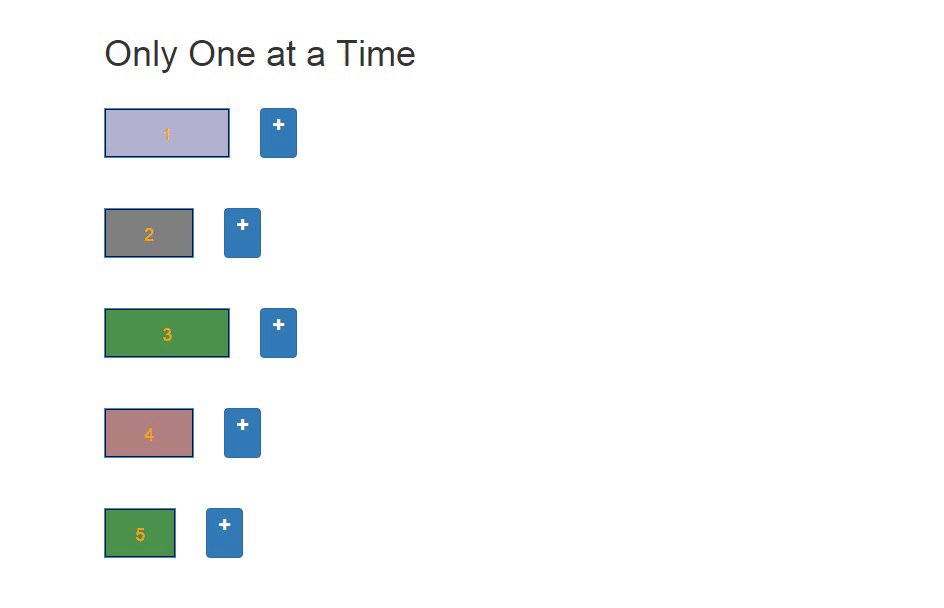I am looking for some help with my code I have so far.
The main objective is to be able to click on any Plus icon and have it place a cover over all other div blocks.
And when a plus icon is clicked it will also show a div block to the right.
As you will see when block 2 is clicked it does all that is intended.
I am looking for an efficient way to do this with Angular when any plus icon is clicked.
This is just a small sample I show here, in reality there would be 10 to 20 blocks to cover.
If someone could see a way to use less code here and make better use of the scope, this would be greatly appreciated.
I have looked at many options like in this post here.
Tried this but it doesn't want to work...
data-ng-class="{coverThisBlock: value2 == 'off',coverThisBlock: value == 'on'}"
If I had to use this type of option with even say 10 blocks, it would be a real mess.
The main Questions
Is there a better Angular way for this to work... when any plus icon is clicked it changes scope to then be used by ngclass and ng-show?
How to correctly wire up scope for this example?
Many Thanks.
I have set up a working FIDDLE HERE.
HERE IS THE FINAL WORKING EXAMPLE by Avijit Gupta.
<div class="container" ng-app="plusMinusApp" ng-controller="plusMinusController">
<div class="row" ng-init="value1 = 'off'">
<!--<div class="col-xs-4" data-ng-class="{coverThisBlock: value2 == 'off',coverThisBlock: value == 'on'}"> -->
<div class="col-sm-4 col-xs-6" data-ng-class="{coverThisBlock: value2 == 'off'}">
<div class="divClass"
data-ng-click="(selectBlock(1)) ; (status1 = !status1) ; (value1 = { 'on': 'off', 'off':'on'}[value1])"
data-ng-class="{'active-selection': status1 == activeClass}">
1
</div>
<i ng-click="(selectBlock(1)) ; (status1 = !status1) ; (value1 = { 'on': 'off', 'off':'on'}[value1])"
class="btn btn-primary text-center fa"
ng-class="{'fa-minus': status1, 'fa-plus': !status1}"></i>
</div>
<div ng-show="value1 == 'on'" class="col-xs-4 textdiv">Hello</div>
</div>
<div class="row" >
<div class="col-sm-4 col-xs-6" ng-init="value2 = 'on'">
<div class="divClass"
data-ng-click="(value2 = { 'on': 'off', 'off':'on'}[value2])"
data-ng-class="{'active-selection': value2 == 'off'}">
2
</div>
<i ng-click="(value2 = { 'on': 'off', 'off':'on'}[value2])"
class="btn btn-primary text-center fa"
ng-class="{'fa-minus': (value2 == 'off'), 'fa-plus': value2}"></i>
</div>
<div ng-show="value2 == 'off'" class="col-xs-3 textdiv">Hello</div>
</div>
<div class="row">
<div class="col-sm-4 col-xs-6" data-ng-class="{'coverThisBlock': value2 == 'off'}">
<div class="divClass"
data-ng-click="(selectBlock(3)) ; (status3 = !status3)"
data-ng-class="{'active-selection': !status3 == activeClass}">
3
</div>
<i ng-click="(selectBlock(3)) ; (status3 = !status3)"
class="btn btn-primary text-center fa"
ng-class="{'fa-minus': status3, 'fa-plus': !status3}"></i>
</div>
</div>
<div class="row">
<div class="col-sm-4 col-xs-6" data-ng-class="{'coverThisBlock': value2 == 'off'}">
<div class="divClass"
data-ng-click="(selectBlock(1)) ; (status4 = !status4)"
data-ng-class="{'active-selection': status4 == activeClass}">
4
</div>
<i ng-click="(selectBlock(1)) ; (status4 = !status4)"
class="btn btn-primary text-center fa"
ng-class="{'fa-minus': status4, 'fa-plus': !status4}"></i>
</div>
<div ng-show="status4" class="col-xs-4 textdiv">Hello</div>
</div>
<div class="row" ng-init="value = 'off'">
<div class="col-sm-4 col-xs-6" data-ng-class="{'coverThisBlock': value2 == 'off'}">
<div class="divClass"
data-ng-click="(selectBlock(1)) ; (status = !status) ; (value = { 'on': 'off', 'off':'on'}[value])"
data-ng-class="{'active-selection': status == activeClass}">
5
</div>
<i ng-click="(selectBlock(1)) ; (status = !status) ; (value = { 'on': 'off', 'off':'on'}[value])"
class="btn btn-primary text-center fa"
ng-class="{'fa-minus': status, 'fa-plus': !status}"></i>
</div>
<div ng-show="value == 'on'" class="col-xs-4 textdiv">Hello</div>
</div>
</div>
<script src="https://ajax.googleapis.com/ajax/libs/angularjs/1.4.8/angular.min.js"></script>
<script src="js/plusMinusApp.j"></script>
<script>
var myModule = angular.module('plusMinusApp', []);
myModule.controller('plusMinusController', function ($scope) {
$scope.status = false;
$scope.status1 = false;
$scope.status2 = false;
$scope.status3 = false;
$scope.status4 = false;
$scope.blocks = [{
id: '1',
block: "1",
}, {
id: '2',
block: "2",
}, {
id: '3',
block: "3",
}, {
id: '4',
block: "4",
}, {
id: '5',
block: "5"
}];
// $scope.activeClass = 0;
$scope.selectBlock = function(id) {
$scope.activeClass = id;
console.log(id);
};
});
</script>
TO ANSWER THE QUESTION TO DO WITH NG-REPEAT
Can ng-repeat use multiple css classes for each different div
Apparently it can.
By using the scope id like this...
<div class="block-{{block.id}}">
and the css like this...
.block-1 {...


